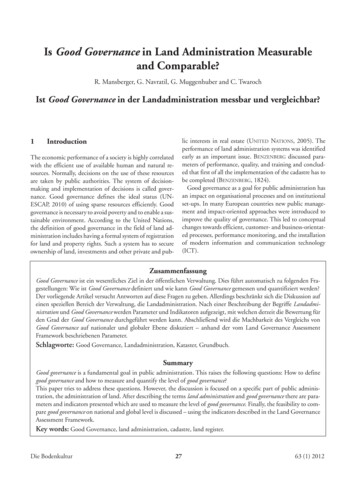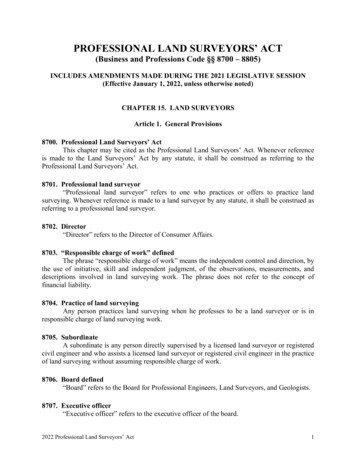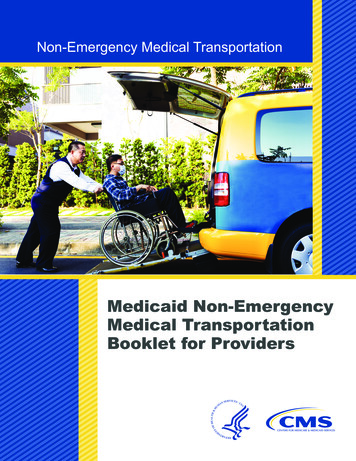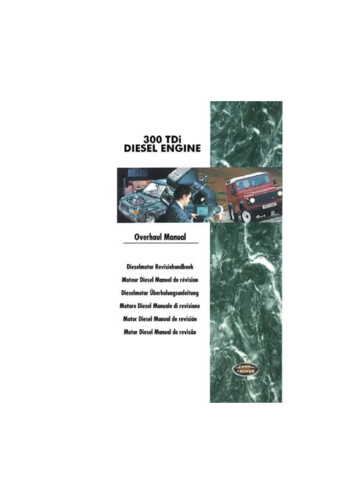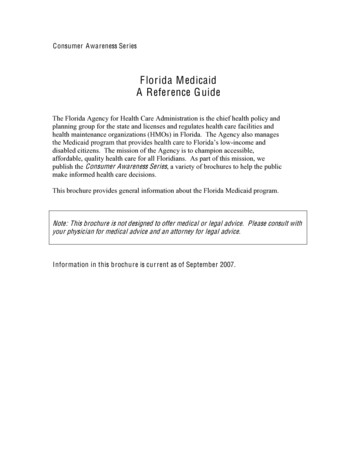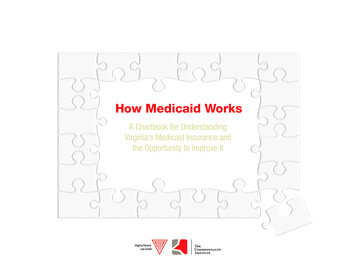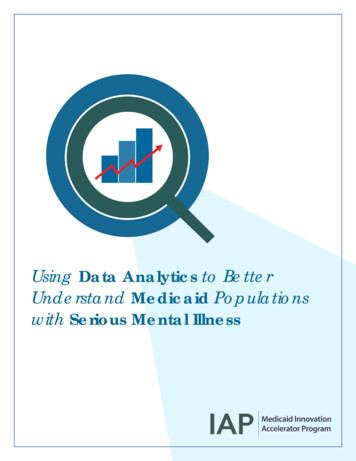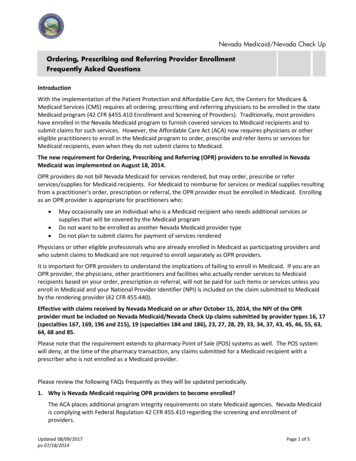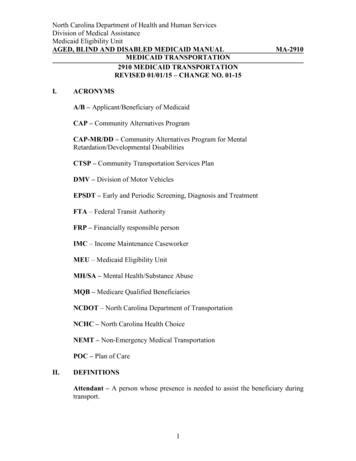
Transcription
North Carolina Department of Health and Human ServicesDivision of Medical AssistanceMedicaid Eligibility UnitAGED, BLIND AND DISABLED MEDICAID MANUALMEDICAID TRANSPORTATION2910 MEDICAID TRANSPORTATIONREVISED 01/01/15 – CHANGE NO. 01-15I.MA-2910ACRONYMSA/B – Applicant/Beneficiary of MedicaidCAP – Community Alternatives ProgramCAP-MR/DD – Community Alternatives Program for MentalRetardation/Developmental DisabilitiesCTSP – Community Transportation Services PlanDMV – Division of Motor VehiclesEPSDT – Early and Periodic Screening, Diagnosis and TreatmentFTA – Federal Transit AuthorityFRP – Financially responsible personIMC – Income Maintenance CaseworkerMEU – Medicaid Eligibility UnitMH/SA – Mental Health/Substance AbuseMQB – Medicare Qualified BeneficiariesNCDOT – North Carolina Department of TransportationNCHC – North Carolina Health ChoiceNEMT – Non-Emergency Medical TransportationPOC – Plan of CareII.DEFINITIONSAttendant – A person whose presence is needed to assist the beneficiary duringtransport.1
North Carolina Department of Health and Human ServicesAGED, BLIND AND DISABLED MEDICAID MANUALMEDICAID TRANSPORTATIONREVISED 01/01/15 – CHANGE NO. 01-15(II.)MA-2910Case Head – The person whose name appears next to “Case Head” on the“home” tab of NCFAST and on minor’s Medicaid identification cards.Certification Period – The period of time for which assistance is requested andin which all eligibility factors except need and reserve (when applicable) must bemet. Generally, certification periods last 6 or 12 months.Community Alternatives Program (CAP) – The Community AlternativePrograms (CAP) provide sets of services (called “waiver services”) not normallycovered under the NC Medicaid programs. The waivers allow individuals whoare in need of institutional care to remain in the home. A CAP beneficiary, who iseligible for Non-Emergency Medicaid Transportation, may be transported to anyservice listed in the Medicaid column in the CAP plan of care (see IV.C.6. forexceptions).Community Transportation Plan (CTP) – a five year plan to addresstransportation needs and resources of the community transit system designated toprovide coordinated transportation at the County level. Every county has anapproved Community Transportation Services Plan (CTSP). See IV.D.Deductible –A Medicaid deductible is an amount of medical expenses that mustbe incurred before Medicaid can be authorized when a Medicaid applicant’sincome exceeds the limit.DMV Search – The county DSS has access to the Division of Motor Vehiclesdata base. Income Maintenance Caseworkers conduct inquiries (searches) in thisdata base when determining eligibility for Medicaid programs.Dually Eligible – Individuals who are eligible for both Medicare and fullMedicaid.Early and Periodic Screening, Diagnosis and Treatment (EPSDT) – A federalMedicaid requirement that requires the state Medicaid agency to cover services,products, or procedures for Medicaid beneficiaries under 21 years of age if theservice is medically necessary health care to correct or ameliorate a defect,physical or mental illness, or a condition [health problem] identified through ascreening examination, (includes any evaluation by a physician or other licensedclinician).2
North Carolina Department of Health and Human ServicesAGED, BLIND AND DISABLED MEDICAID MANUALMEDICAID TRANSPORTATIONREVISED 12/01/12 – CHANGE NO. 06-12(II.)MA-2910Family Members & Friends – Family members other than spouses and parentsof minor children, as well as other non-related individuals, who comprise aMedicaid beneficiary’s potential support for transportation needs.Financially Responsible Person (FRP) – For Medicaid purposes, includingNEMT, spouses are financially responsible for one another, and parents arefinancially responsible for their minor children.Gas Voucher – A voucher that is issued to the beneficiary/FRP or other driverwith which he may purchase gasoline at a contracted station.Least Expensive Means – Most cost effective mode of transportation.Medically Necessary Ambulance Transport – Medically necessary means thebeneficiary’s condition requires ambulance transportation and any other means oftransportation would endanger the beneficiary’s health or life.Medicare Qualified Beneficiary – MQB (Q, B or E) –Medicaid programs forMedicare beneficiaries that offer limited benefits. MQB beneficiaries are noteligible for Medicaid transportation assistance.Mental Health/Substance Abuse (MH/SA) Enhanced Benefits – A list ofservices covered by Medicaid for which the cost of transport is included in theprovider reimbursement rates. These services are not eligible for Medicaidtransportation assistance. (See IV.C.6.b.)Mileage Reimbursement – Reimbursement to a Medicaid beneficiary/FRPand/or other driver based on a specific rate per mile driven to allow a Medicaidbeneficiary to receive covered services.Mobility Device – wheelchair, scooter or other device used to aid personalmobility.Non-Emergency Medical Necessity – The need for ambulance-type transportdue to a medical or physical condition that precludes transport in a regular motorvehicle. This involves a person who is bed-confined and must be transported on astretcher via ground transport.Non-Emergency Medical Transportation (NEMT) – Transportation to andfrom medical services on a non-emergent basis. Emergency transportation needsare provided by emergency service vehicles and are billed directly to Medicaid bythe provider. NEMT needs for Medicaid beneficiaries are addressed by thecounty Medicaid transportation coordinator when requested.3
North Carolina Department of Health and Human ServicesAGED, BLIND AND DISABLED MEDICAID MANUALMEDICAID TRANSPORTATIONREVISED 01/01/15 – CHANGE NO. 01-15(II.)MA-2910Normal Service Area is the geographical area within which Medicaid consumersand the general population in the county routinely access Medicaid services. Thenormal service area can cross a county or state border.North Carolina Health Choice (NCHC) – A medical coverage program forindividuals under age 19. Beneficiaries of NCHC are not eligible for Medicaidtransportation assistance. Verify the program with the Income MaintenanceCaseworker or in the Eligibility Information System (EIS).No-Shows/No-Show Policy – A no-show occurs when a Medicaid beneficiary isscheduled for a trip to a medical service and fails to show up to be transported. Ano-show policy consists of rules governing missed transportation pick-ups.Plan of Care (POC) – A document which summarizes the CAP evaluation andassessment information into a statement of how the beneficiary’s needs are to bemet; outlines goals and objectives; and indicates the specific services needed, bothformal and informal.Provider – An individual or entity that provides a medical service, such as adoctor, hospital or pharmacy.Public Transportation – or public transit is shared transportation available foruse by the general public. Public transportation includes buses, trolleys, trains,and ferries, share taxi in areas of low-demand, and paratransit for people whoneed a door-to-door service.Transportation Vendors consist of businesses with which the county contractsto provide Non-Emergency Medicaid Transportation. Vendors may be public,such as local transit systems, or private, such as private van services.Review/Reenrollment – Medicaid cases are reviewed at the end of eachcertification period to re-determine eligibility for the Medicaid programs.Series of Appointments – A group of transportation dates for medical serviceswith the same medical provider which are requested and approved at the sametime, rather than as they occur.Suitable Transportation – The mode of transportation that is appropriate to theMedicaid beneficiary’s medical and other identified needs.4
North Carolina Department of Health and Human ServicesAGED, BLIND AND DISABLED MEDICAID MANUALMEDICAID TRANSPORTATIONREISSUED 01/01/15 – CHANGE NO. 01-15(II.)MA-2910Transportation Coordinator – The person designated by the county DSS tocoordinate Medicaid transportation trips. This person may be employed by theDSS or by an entity under contract with the DSS to arrange transportationTrip – A NEMT “trip” consists of the length between one pick-up and drop-off.For example, picking up a beneficiary at his home and driving him to a doctor’soffice is one trip. If the same beneficiary is picked-up at the doctor’s office anddriven back to his home that is a second trip. If before being driven home, thesame beneficiary is driven to a drug store that would constitute a third trip.Urgent Transportation Need– A need for transportation to a medical servicewhich does not warrant ambulance transport, but cannot be postponed to anothertime. Examples include acute illnesses and non-emergent injuries, as well asnecessary medical care that cannot be rescheduled to another time (i.e., due toprovider availability, etc.).Vendor No-Show – The failure of a transportation vendor to pick-up abeneficiary for a scheduled trip.Volunteers/Volunteer Drivers – Individuals screened and approved by thecounty DSS to transport Medicaid beneficiary, either in their own vehicles or inagency vehicles.Voucher – A document exchangeable for goods or services.III.BACKGROUNDTitle XIX of the Social Security Act requires that state Medicaid programs fulfilladministrative requirements necessary to operate the Medicaid programefficiently. Among these administrative requirements is the mandate that StatePlans “specify that the Medicaid agency will ensure necessary transportation forbeneficiary to and from providers” (See 42 CFR 43l.53).IV.POLICY PRINCIPLESTransportation to and from providers is a critical component for Medicaidbeneficiary to obtain necessary health care. Non-Emergency MedicalTransportation (NEMT) services consist of arranging and/or paying fortransportation. When the beneficiary has access to a suitable mode oftransportation, but lacks the means to use it, the county must assist with the meansthrough gas vouchers, mileage reimbursement, etc. When the beneficiary lacksboth means and mode, the county is responsible for arranging transportation at acost within allowable Medicaid regulations. However, the obligation to providetransportation is not without qualifications.5
North Carolina Department of Health and Human ServicesAGED, BLIND AND DISABLED MEDICAID MANUALMEDICAID TRANSPORTATIONREVISED 01/01/15 – CHANGE NO. 01-15(IV.)MA-2910A. Transportation CriteriaFederal regulations require that the state assure necessary transportation (see42 CFR 431.53). Necessary means no other appropriate transportationresources are available to the beneficiary.Medicaid only pays for transportation:1.By the least expensive mode available and appropriate for thebeneficiary (see VIII.C.1.),2.To the nearest appropriate medical provider (see VIII.B.);3.For a Medicaid-covered service (see VIII.A.) provided by a NCenrolled Medicaid provider.B. Early and Periodic Screening, Diagnosis and Treatment (EPSDT)EPSDT is a federal Medicaid requirement that requires the state Medicaidagency to cover services, products, or procedures for Medicaid beneficiariesunder 21 years of age if the service is medically necessary health care tocorrect or ameliorate a defect, physical or mental illness, or a condition [healthproblem] identified through a screening examination (includes any evaluationby a physician or other licensed clinician).The county DSS must arrange for or provide transportation to childrenmeeting EPSDT requirements for necessary services that might not be coveredunder the Medicaid state plan but are covered under EPSDT. When EPSDTbeneficiaries request transportation for a non-covered service, verify with theprovider that prior approval was obtained. If unable to obtain a copy of theapproval letter from the provider, call the DMA Clinical Policy section toverify prior approval. Clinical Policy can be reached by calling (919) 8554260.C. Beneficiaries Not Eligible for Transportation Assistance1.MQB-Q, B, or E beneficiaries (Note that dually eligible individuals areentitled to transportation assistance, including transportation to pick upprescriptions, even though Medicaid does not pay for their prescriptiondrugs).6
North Carolina Department of Health and Human ServicesAGED, BLIND AND DISABLED MEDICAID MANUALMEDICAID TRANSPORTATIONREVISED 01/01/15 – CHANGE NO. 01-15(IV.C.)MA-29102.Beneficiaries in deductible status. An applicant/ beneficiary is noteligible for Medicaid transportation assistance until his deductible ismet.3.North Carolina Health Choice (NCHC) beneficiaries4.Nursing home beneficiaries (see X.D.)5.Certain mental health services have transportation costs included in theMedicaid provider’s fee; therefore beneficiaries are not eligible forNEMT to these services.a. The following Community Alternative Program – MentalRetardation/Developmental Disabilities (CAP-MR/DD) Waivercovered services have transportation included in the Medicaidprovider’s fee:CAP-MR/DD SERVICEDay Supports – IndividualDay Supports – GroupSupported Employment – IndividualSupported Employment – GroupCODET2021T2021HQH2025H2025HQb. The following Mental Health/Substance Abuse (MH/SA) Benefitscovered services have transportation included in the Medicaidprovider’s fee:MENTAL HEALTH/SUBSTANCE (MH/SA)ABUSE ENHANCED SERVICEAssertive Community Treatment Team (ACTT)Intensive In-Home ServicesMobile CrisisMulti-systemic Therapy (MST) (for ages 7-17)7CODEH0040H2022H2011H2033
North Carolina Department of Health and Human ServicesAGED, BLIND AND DISABLED MEDICAID MANUALMEDICAID TRANSPORTATIONREISSUED 01/01/15 – CHANGE NO. 01-15(IV.C.5.b.)MH/SA BENEFIT SERVICEProfessional Treatment Services in Facility-BasedCrisis ProgramSubstance Abuse Medically Monitored ResidentialTreatmentSubstance Abuse Non-Medical CommunityResidential TreatmentMedically Supervised Detoxification/CrisisStabilizationNon-Hospital Medical 10D. County Participation in Community Transportation Services Plan(CTSP)Every county has an approved Community Transportation Services Plan(CTSP) which must be updated periodically. The purpose of a CTSPincludes:1.Develop and promote the full integration of the communitytransportation system’s programs with other federal and state programssupporting public and human service transportation;2.Support and promote the coordination of public transportation servicesacross geographies, jurisdictions, and program areas for thedevelopment of a seamless transportation network;3.Support the provision of dependable transportation options to thegeneral public, low income individuals, elderly persons, and/orpersons with disabilities within the guidelines and funding levelsprovided by NCDOT and FTA.To assure that transportation is provided to Medicaid beneficiaries in a timelyand cost-effective manner, the county is encouraged to participate in CTSPdevelopment of the planning, design and delivery of local Medicaidtransportation services.8
North Carolina Department of Health and Human ServicesAGED, BLIND AND DISABLED MEDICAID MANUALMEDICAID TRANSPORTATIONREVISED 01/01/15 – CHANGE NO. 01-15V.MA-2910Beneficiary’s Rights and ResponsibilitiesA. Rights of the Beneficiary1.To be informed of the availability of Medicaid transportation. (SeeVI.A.1.).2.To have the transportation policy explained including: how to requesta trip or cancel a trip, limitations on transportation, suspensions forconduct and no-shows.3.To be transported to medical appointments if unable to arrange or payfor transportation:a. By means appropriate to circumstances (See VIII.C.).b. To arrive at medical provider in time for his scheduledappointment.4.To request a hearing if the request for transportation assistance isdenied.B. Responsibilities of the Beneficiary1.To use those transportation resources which are available andappropriate to his needs in the most efficient and effective manner.2.To travel to the requested location and receive a Medicaid coveredservice.3.To make timely requests for transportation assistance (See VII.F. forwhat constitutes a timely request).4.To be ready and at the designated place for transportation pick-up orcancel the transportation request timely (See VII.G.1.b. below for whatconstitutes timely cancellation).5.To follow the instructions of the driver.6.To respect the rights of other passengers and the driver, such as notcreating a disturbance or engaging in threatening behavior.9
North Carolina Department of Health and Human ServicesAGED, BLIND AND DISABLED MEDICAID MANUALMEDICAID TRANSPORTATIONREVISED 01/01/15 – CHANGE NO. 01-15VI.MA-2910County’s Responsibilities (also see IX Safety and Risk Management)A. Inform A/B of Right to Transportation Assistance1.The county must give or mail the DMA-5046, Medical TransportationAssistance – Notice of Rights/Responsibilities to the A/B at eachMedicaid application and Medicaid reenrollment. This includes alltypes of eligibility except Medicare Qualified Beneficiaries (MQB),North Carolina Health Choice, and those beneficiaries who reside inlong term care facilities.2.It is not necessary to have a copy filed in the record if thedocumentation indicates that the DMA-5046 was mailed to thebeneficiary.3.Explain that a transportation assessment may be made in person, bytelephone or by mail.4.Explain the procedure for making a trip request, including the advancenotice policy.5.Notice and Appeal Rightsa. Explain that the A/B has the right to a written response if hisrequest for transportation assistance is denied.b. Explain that the beneficiary has the right to appeal at a localhearing if his request for transportation assistance has been deniedor if he disagrees with the particular mode of transportation forwhich he has been approved.10
North Carolina Department of Health and Human ServicesAGED, BLIND AND DISABLED MEDICAID MANUALMEDICAID TRANSPORTATIONREVISED 01/01/15 – CHANGE NO. 01-15(VI.)MA-2910B. Coordination of Transportation1.The county must ensure that transportation services are coordinated.The county must have an individual who is responsible for:a. Receiving transportation trip requests;b. Completing the DMA-2056, Transportation Log, or equivalentform that captures all of the DMA-2056 data fields, to track eachtrip request from intake through disposition.c. Arranging and coordinating transportation services.d. Providing DMA, Medicaid Eligibility Unit (919-855-4000) thecounty transportation coordinator’s name and contact informationand contacting DMA at the above number when the designationchanges; ande. Developing and maintaining an automated and print ready list ofthe various modes of NEMT available in the county ranked fromno cost options, such as community resources, to the most costly.Community resources include: civic, religious and volunteeragencies, as well as public transportation systems and privatetransportation businesses.f. Maintaining the transportation file (see VI.C.)2.Communication between income maintenance and transportation staffa. The IMC is responsible for handing or mailing the DMA-5046,Medicaid Transportation Assistance -- Notice of Rights andResponsibilities to beneficiaries who are potentially eligible forNEMT (MAF-C, MIC, MAA, MAB, MAD) at each applicationand reenrollment;b. If the IMC does the assessment, the IMC must forward a copy ofthe DMA-5046, Medical Transportation Assistance Notice ofRights/Responsibilities, the DMA-5047, Medicaid TransportationAssessment, and the DMA-5024, Transportation AssessmentNotification to the transportation coordinator.11
North Carolina Department of Health and Human ServicesAGED, BLIND AND DISABLED MEDICAID MANUALMEDICAID TRANSPORTATIONREVISED 01/01/15 – CHANGE NO. 01-15(VI.B.2.)MA-2910c. When a trip request is made, the transportation coordinator or thecoordinator’s designee must verify Medicaid eligibility.C. Documentation and Forms1.The county must maintain a transportation file for each eligibleindividual or family, labeled with the casehead’s name. Thetransportation coordinator must assure that the file contains thefollowing documents:a. A copy of the DMA-5046, Medical Transportation AssistanceNotice of Rights/Responsibilities, unless documented that it wasmailed to the beneficiary (see VI.A.1.);b. DMA-5047, Medicaid Transportation Assessment completedduring the current certification period or within the past 12 months,which reflects the beneficiary’s most current circumstances andneeds;c. DMA-5048, Medicaid Transportation Exception Verification form(when applicable);d. A copy of each prior approval letter (including EPSDT serviceprior approvals) or name of individual at DMA Clinical Policy orMEU who verified prior approval (when applicable);e. DMA-5024, Transportation Assessment Notification.f. DMA-5125, Medicaid Transportation No-show, First Notice,DMA-5125A, Medicaid Transportation No-show, Final Notice,DMA-5125B, Medicaid Transportation Suspension Notice (whenapplicable).2.Tracking trip requests.The county must track each trip request from intake throughdisposition.a. Each trip request made by a Medicaid beneficiary must be loggedon the DMA-2056, Transportation Log, or equivalent form whichcaptures all of the DMA-2056 data fields.12
North Carolina Department of Health and Human ServicesAGED, BLIND AND DISABLED MEDICAID MANUALMEDICAID TRANSPORTATIONREVISED 01/01/15 – CHANGE NO. 01-15(VI.C.2.)MA-2910b. If administration of NEMT is contracted out, the vendor is requiredto carry out all the responsibilities placed upon the county byNEMT policy. The Contractor must log all trips using the DMA2056 or equivalent documentation. The contractor must submit adetailed invoice to the county such that the county can compare theamount billed to the corresponding trip.Note: The county DSS shall not use a vendor’s invoice as the log, oruse the invoice to complete the DMA-2056 after the fact, except torecord trip costs reported by the vendor.D. Hours of Operation1.The county shall provide transportation after normal business hourswhen the medical service required by the beneficiary is available onlyduring those hours.2.The county shall have a phone system with an answering machine orother message recording device for taking transportation requests orcancellations 24 hours per day. The messages shall be retrieved duringnormal business hours. The instructions to clients on the answeringmachine or other recording device shall advise callers to dial 911 ifthey are having an emergency.E. Compliance with Transportation PolicyThe providence of Medicaid transportation services to those who are in needof those services and the proper utilization of those services by beneficiariesare important goals of Medicaid transportation policy. In order to attain thesegoals, the county must randomly sample 2% of the trips, or 200 tripswhichever is less, on the DMA-2056, Transportation Log, or equivalent form,per quarter. For monitoring purposes, a trip is transportation of a beneficiaryto and from one provider. Trips billed as administrative cost on the DSS-1571must be included in the random sample. If an equivalent form is used, thatform must capture all of the data fields contained in the DMA-2056. Allmodes of transportation must be included in the sample.Use the DMA-5078, Medicaid Transportation Monitoring Report to documentfindings. The following aspects of each file must be reviewed:1.Was the beneficiary authorized for Medicaid on the date of the trip?13
North Carolina Department of Health and Human ServicesAGED, BLIND AND DISABLED MEDICAID MANUALMEDICAID TRANSPORTATIONREISSUED XX/01/12 – CHANGE NO. 01-15(VI.E.)MA-29102.Was the beneficiary in an eligible Medicaid category programcategory?3.Was the beneficiary transported to a Medicaid enrolled provider?4.Did the beneficiary receive a Medicaid covered service?a. Contact the provider and determine if the beneficiary received amedical service on the trip date.b. Verify that the service received is a Medicaid covered service (seeVIII.A.).5.Is there a current DMA-5048, Transportation Exception VerificationForm in the file?6.Is there a current DMA-5046, Notice of Rights in the file?7.Is there a current DMA-5047, Medicaid Transportation Assessment, inthe file?8.Is there a current DMA-5024, Transportation Assessment Notification,in the file?9.Was the calculation of the reimbursement for the trip/related expensesdone correctly?10.Was a DMA-5119, Denial of Transportation Request, provided to thebeneficiary (if applicable)?11.Was the trip coded correctly for reimbursement on the DMA-2056,Transportation Log?14
North Carolina Department of Health and Human ServicesAGED, BLIND AND DISABLED MEDICAID MANUALMEDICAID TRANSPORTATIONREVISED 01/01/15 – CHANGE NO. 01-15VII.MA-2910ProcedureWhen a request for transportation is made, follow the procedures below.A. Assessment of NeedA DMA-5047, Medical Transportation Assessment, must be completed in itsentirety at the initial request for transportation assistance, once a yearthereafter and when there is a change in circumstances which may impact theneed for transportation assistance, and to coincide with each Medicaid reviewor reenrollment, if the beneficiary is still in need of services. An assessmentmust be completed at least every twelve months for SSI beneficiaries or asneeded when a reported change in circumstances may impact the beneficiary’sneed for transportation services.Follow the same NEMT policy for foster children. A foster parent is classifiedas a non-financially responsible relative friend. An assessment must be doneto determine whether the foster care parent has the means to transport thebeneficiary to medical appointments. Note; foster parents are required to havea working vehicle as part of the foster care agreement.Assess how medical transportation has previously been provided and why it isnot available now (Section B of DMA-5047).1.Does the A/B have access to a vehicle that can be used to get to andfrom medical appointments?a. Beneficiary’s vehicleAsk the A/B and/or financially responsible person if he has aworking car or truck.b. Friend, relative, neighborAsk A/B if he has friends, relatives or neighbors who would bewilling to transport him to medical appointments.c. If it is determined that the A/B is able to provide his owntransportation, his request should be denied on the DMA-5024.15
North Carolina Department of Health and Human ServicesAGED, BLIND AND DISABLED MEDICAID MANUALMEDICAID TRANSPORTATIONREVISED 01/01/15 – CHANGE NO. 01-15(VII.A.)2.MA-2910Ask the A/B how he has been getting to the store and to medicalappointments,a. Drives self.b. Friend/relative/neighbor provides transportationc. Takes a bus.d. Takes a cab.e. Agency provides transportation.Document the name of the agency3.Ask if there is a reason the A/B can no longer use the source he had beenusing for transportation to get to medical appointments.a. If the A/B has access to a vehicle, find out why that vehicle cannotcurrently be used to transport him to medical appointments. If A/B statesthat he cannot afford to pay for gas, explain that gas reimbursement isavailable.b. Ask the beneficiary if he has any physical and/or mental impedimentswhich limit his ability to use available transportation. If physical ormental impediments are claimed, complete the DMA-5048 followinginstructions in VII.C.2.c. If the A/B states that he cannot afford to pay (for gas, bus fare, car repairs,insurance, vehicle registration, cab fare, etc.) accept his statement.4.Community based transportation resourcesCommunity based transportation resources include civic, religious andvolunteer agencies, as well as public transportation systems. These resourcesmust be exhausted before using paid transportation.a. Check resource listing(s) to determine if the beneficiary has access toindividual or community based transportation and is able to get to thepickup location.b. If community based transportation resources, such as that offered by theCouncil on Aging, are available to the A/B and there is no impediment tohis utilizing them, complete a DMA-5024 and deny his request.16
North Carolina Department of Health and Human ServicesAGED, BLIND AND DISABLED MEDICAID MANUALMEDICAID TRANSPORTATIONREVISED 01/01/15 – CHANGE NO. 01-15(VII.)MA-2910B. Assessment by Other EntitiesThe county may subcontract with other entities to have transportation assessmentscompleted. However, before any assistance can be provided the county DSS isresponsible for assuring that1.The subcontractor meets all the assessment requirements, includingcompletion of the DMA-5047; and2.Documentation of the assessment decisions, copies of notices, authorizations,etc. are received by DSS and comply with guidelines.C. Special Needs (Section C of DMA-5047)1.Ask the A/B about special needs or impediments to using certain forms oftransportation. Does the A/B use/require:a. An attendant (required for children under age 18 unless they areemancipated), who may or may not be a parent. Other beneficiaries mayneed attendants due to special medical, physical or mental impediments;b. Mobility Device – ask what type of mobility device is used (wheelchair,scooter, etc.);c. Cane/crutches/walker;d. Portable oxygen tank;e. Service animal;Orf. Have a condition, such as blindness, deafness or disorientation which canimpact transportation options;2.DMA-5048, Medicaid Transportation Exception Verification FormWhen the A/B requests transportation assistance and alleges a physical ormental impediment that prevents the use of an available resource, and thatimpediment is not obvious to the individual performing the assessment,complete the DMA-5048, Medicaid Transportation Exception VerificationForm.17
North Carolina Department of Health and Human ServicesAGED, BLIND AND DISABLED MEDICAID MANUALMEDICAID TRANSPORTATIONREVISED 01/01/15 – CHANGE NO. 01-15(VII.C.2.)MA-2910The DMA-5048 is also used when the A/B alleges a need for transportation toa provider ou
Non-Emergency Medical Necessity - The need for ambulance-type transport due to a medical or physical condition that precludes transport in a regular motor vehicle. This involves a person who is bed-confined and must be transported on a stretcher via ground transport. Non-Emergency Medical Transportation (NEMT) - Transportation to and
